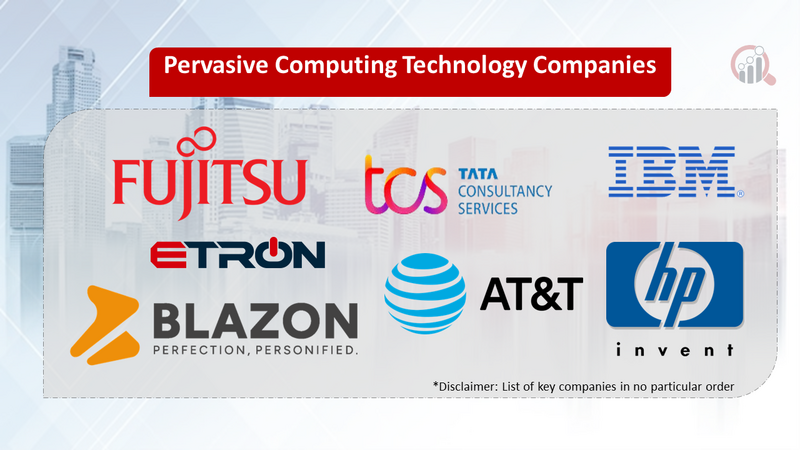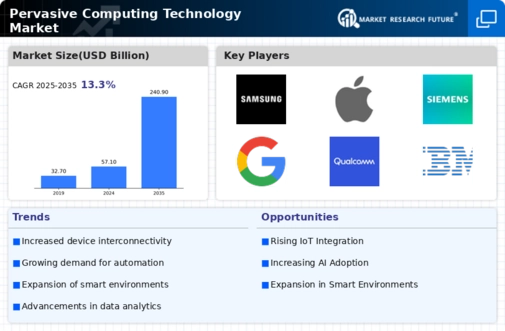Top Industry Leaders in the Pervasive Computing Technology Market

Competitive Landscape of Pervasive Computing Technology Market: A Deep Dive
The pervasive computing technology market, encompassing the seamless integration of computing into our everyday lives, is experiencing explosive growth. Driven by the Internet of Things (IoT), smart sensors, and AI-powered analytics. This dynamic landscape necessitates a closer look at its key players, strategies, and investment trends.
Key Players:
-
Blazon Marketing Inc.
-
E-Tron CO. Ltd.
-
Hewlett-Packard
-
Neo Metal Co., Ltd.
-
Palo Alto Research center Incorporated (PARC)
-
T&T Inc.
-
Maruhachi Warehouse Co., Ltd.
-
IBM Corporation
-
Fujitsu Laboratories of America, Inc.
-
Tata Consultancy Services Limited.
Strategies Adopted:
-
Partnerships and Acquisitions: Collaboration through partnerships and strategic acquisitions is a key strategy for expanding market reach and acquiring new technologies. For example, Microsoft's acquisition of LinkedIn strengthened its position in pervasive computing through workplace solutions.
-
Vertical Market Focus: Players are increasingly focusing on specific vertical markets with tailored solutions. Healthcare, retail, and manufacturing are witnessing significant investments in pervasive computing technologies for improved efficiency, automation, and data-driven insights.
-
Open Platforms and Standards: The development of open platforms and standards facilitates interoperability and collaboration, fostering a more cohesive ecosystem and accelerating market growth.
-
Security and Privacy Focus: With increasing concerns about data privacy and security in a connected world, players are prioritizing robust security solutions and transparent data practices to build trust and gain user acceptance.
Factors for Market Share Analysis:
-
Product Portfolio and Innovation: Breadth and depth of product offerings, coupled with a strong focus on continuous innovation, are crucial for market leadership.
-
Brand Recognition and Reputation: Established brands with strong reputations for reliability and security hold an advantage in attracting customers.
-
Geographical Reach and Distribution Channels: Global presence and efficient distribution channels enable players to reach a wider customer base.
-
Pricing Strategies and Value Proposition: Competitive pricing and a compelling value proposition for specific customer segments are essential for market share gains.
-
Investment in Research and Development: Continuous investment in R&D ensures access to cutting-edge technologies and keeps players ahead of the curve.
New and Emerging Companies:
-
Edge Computing Startups: Companies like Fastly and Blazecloud are focusing on edge computing solutions, bringing processing power closer to data sources for faster response times and improved efficiency.
-
Blockchain-enabled Pervasive Computing: Startups like Iota and Hivemind are exploring the potential of blockchain technology to secure and manage data in pervasive computing environments.
-
Low-Power AI Processors: Companies like Arm and Synopsys are developing low-power AI processors specifically designed for pervasive computing devices, enabling on-device intelligence and reducing reliance on cloud computing.
Current Company Investment Trends:
-
Focus on Platform Development: Players are investing heavily in developing open and secure platforms that enable rapid application development and deployment for various use cases.
-
Integration with AI and Machine Learning: AI and ML are being integrated into pervasive computing solutions to enable real-time data analysis, predictive maintenance, and personalized user experiences.
-
Cybersecurity and Data Privacy: Investments in robust cybersecurity solutions and data privacy measures are crucial to address growing concerns and ensure user trust.
-
Sustainability and Energy Efficiency: Developing energy-efficient pervasive computing solutions is becoming a priority to minimize environmental impact and reduce operational costs.
Latest Company Updates:
-
December 15, 2023: Google announces new Project Starline, a next-generation video conferencing system that creates a realistic 3D presence of the other person.
-
December 20, 2023: Microsoft unveils Azure Sphere Guardian, a comprehensive security solution for IoT devices.
-
January 3, 2024: Amazon Web Services launches IoT Core for LoRaWAN, simplifying the development and deployment of LoRaWAN-based IoT applications.
-
January 4, 2024: Ericsson and Siemens partner to develop a digital twin platform for industrial applications, leveraging pervasive computing technologies.

